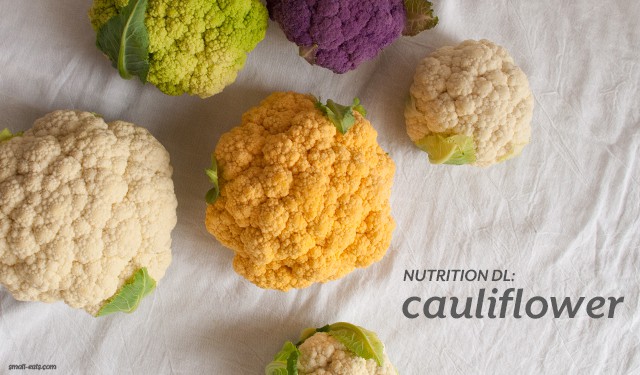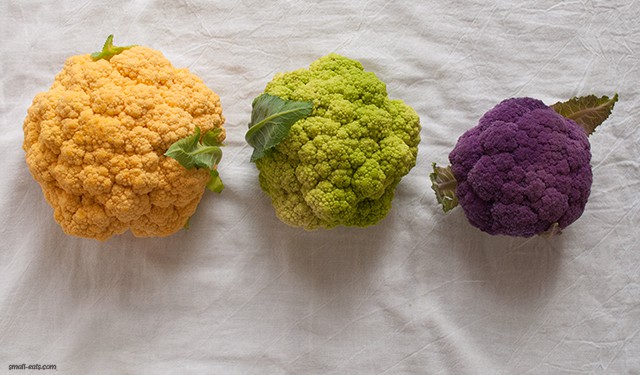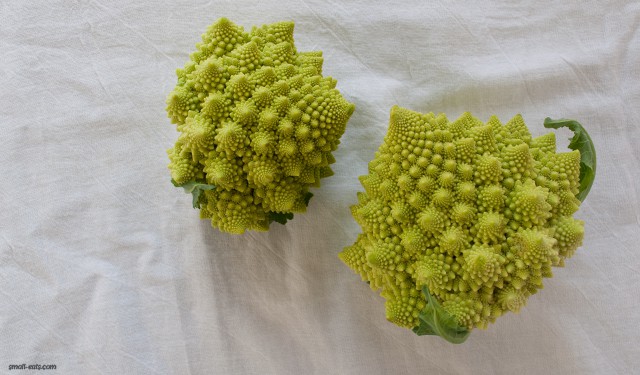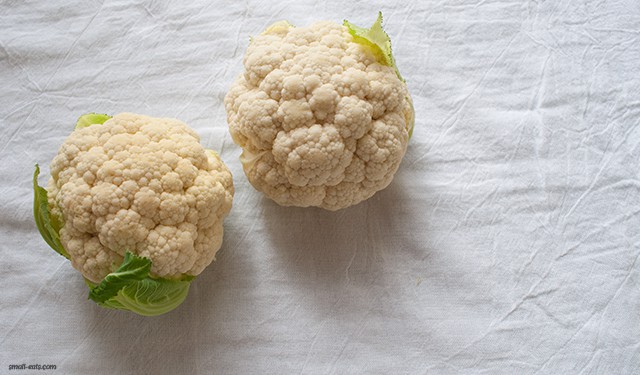
Nutrition DL is a series that gives you the download on seasonal fruits, vegetables, or pantry staples. Once you learn about the nutrition, varieties, and how to select and store the featured ingredient, I share a four recipes over four weeks to inspire and feed you with this great seasonal food. Check out other foods I’ve covered here.
I have been keeping an eye out for months to find the best cauliflower to show you. Cauliflower started popping up at my farmers’ market late last year while the Swiss chard series was running. Once it was done, I was going to buy all of the beautiful colors and varieties and share some great recipes with you. When it was finally time, some of the booths started to carry less! I was worried, but I continued to wait, because I just had to talk about cauliflower. And my patience was rewarded! The bright and captivating colors returned to my markets and I snatched them up to share with you.
Cauliflower is a member of the cruciferous family. Cauliflower’s relatives include broccoli, kale, Brussels sprouts, cabbage, and bok choy, to name a few. Cauliflower grows all year long, but the peak season is the winter. Most of the colored varieties only appear in the winter and in the summer (depending on where you live).
Benefits
Most of the time, the more color a fruit or vegetable has, the more nutrients it has. Cauliflower is an exception to that rule. White cauliflower is rich in glucosinolates. Glucosinolates are phytonutrients that give cruciferous vegetables their unique and bitter flavors. But with that bitterness brings a lot of benefits. Glucosinolates help the body detox, keep inflammation in check, help with digestion.
Cauliflower is low in calories and is also high is fiber, which is great for fullness and keeping everything regulated. If you’re making a vegetable-driven dish and concerned about staying full, add some cauliflower to it. Cauliflower is also very low on the Glycemic Index, meaning your blood sugar won’t spike and you won’t crash after eating cauliflower.
Cauliflower is an excellent source of vitamin K, which aids in helping your blood clot (in a healthy way) and with bone health.
As you may have seen here before, cauliflower is packed with vitamin C. If you eat a cup of cooked cauliflower, you can get over 70% of your daily value of vitamin C in one go! SO if you’re looking to keep your immune system in fighting shape this winter, also add some cauliflower to your lunch or dinner and give yourself that added boost.
If you’re looking to get more healthy fats from foods, cauliflower is for you. It’s a very good source of omega-3 fats, with 9% per cooked cup of cauliflower.

Kinds of Cauliflower
Until I started shopping at farmer’s markets, I thought cauliflower only grew in one, drab color. And boy was I wrong! Cauliflower comes in several beautiful colors: green, light orange, and purple. If you want to get even more of the benefits from cauliflower, grab a colorful variety. They have more antioxidants (that gives them their color) than the white variety does.

There are two different green cauliflower, and they’re pretty easy to tell apart. One looks like your regular cauliflower, except a bright green. Romanesco looks like something different all together. A beautiful sight, romanesco looks like edible fractals (remember that trippy 90s computer art?). They’re very popular in restaurants because they look so unique.
If you go to a health grocery store or a farmer’s market, you’re also more likely to find smaller heads of cauliflower, which is perfect for smaller tables like mine.
Buying and Storing Cauliflower
Cauliflower is on the Environmental Working Group’s Clean Fifteen list, which means it’s fine to by conventional, non-organic cauliflower.
If you want the brighter varieties, your best bet is probably to go to a farmer’s market. Regardless of what color you’re looking for, look for a head that is clean and not covered in brown spots or is dented. This means they’re aging and are losing some nutrients. Make sure the clusters are close together.

Judge the size of the curd (the head itself) and not the leaves. Once you take the leaves off, you can be surprised at how much or how little you actually bought.
Once home, store the heads in a bag in the fridge for a week. It will keep for a little longer, but the nutrient density will be less than within that first week.
Want to get cooking? You can find the recipes from this installment here:
Curried Roasted Cauliflower
Swiss Chard and Tomato Cauliflower Rice
Roasted Cauliflower Greek Yogurt Dip
Quick Roasted Cauliflower Soup
Interested in seeing what other foods I’ve covered in this series? Read up on them here.
